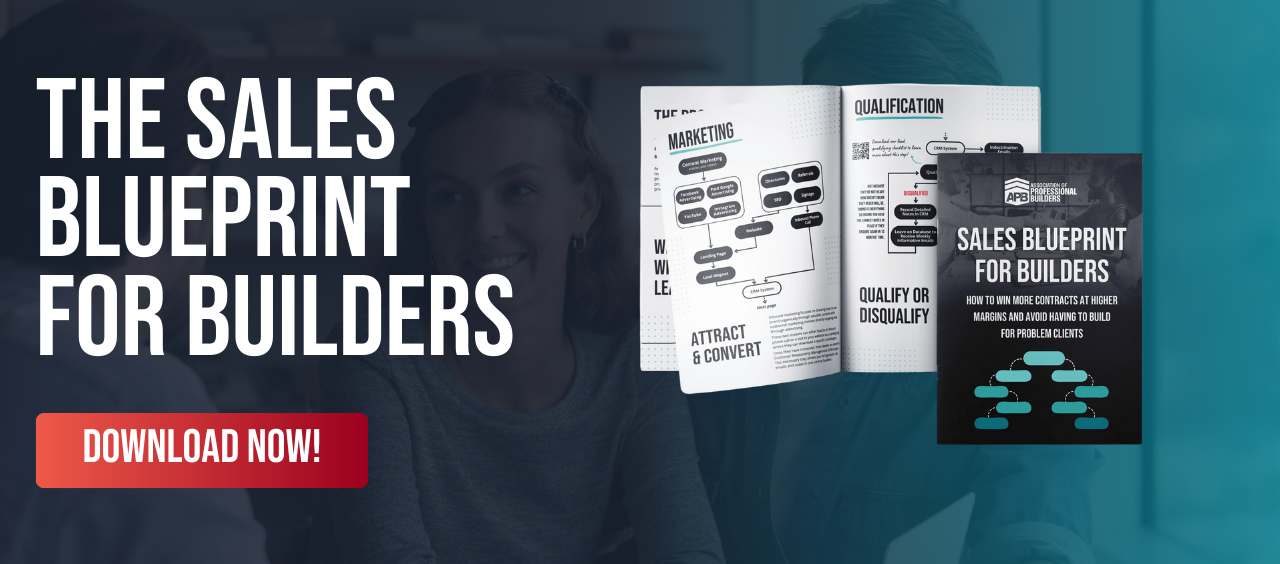Imagine charging higher prices for your custom home projects without the fear of losing potential clients. It’s something within your reach with the right sales process in place.
In the residential construction industry, securing high-margin contracts can be challenging.
Your ideal margins vary depending on the context and nature of the project. For example, 10% net profit is a good goal for new home builders, which means a 33.3% markup. In the case of renovations or remodelling, builders should aim for a 15-20% profit, which comes from around a 55% markup.
Sadly, many builders struggle to reach these benchmarks due to ineffective sales and marketing strategies.
Why do good margins matter?
High-margin contracts mean better profits; having enough profit is essential for your company’s growth and security. Adequate margins enable building companies to build equity and maintain necessary cash reserves as they scale up.
You may think that a 33.3% markup is impossible! But we’re here to break the myth and show you how you can make this happen…
Break The Barrier
Builders often resist the idea of higher margins, particularly those that have been led to believe that charging more than 20 to 25% will not win a job. Fear of losing potential jobs and becoming overly dependent on prospective clients can lead builders to undervalue their services.
Remember that you’re not “ripping off” people when you charge more. You deserve to be well compensated for your expertise, the service you provide, and the risk you take every time a contract is signed.
However, to charge better prices, you need to show clients why you’re worth it, and having a well-established marketing and sales process is the key!
The first step is to attract the right clients using a proven marketing system which will generate more opportunities. You then need to transform those opportunities into high-margin contracts with a repeatable and documented sales process.
You can consider scaling your business once your marketing and sales processes run smoothly. However, to grow sustainably, you also need to remain profitable. A work in progress calculator will help you calculate the hidden liability in the accounts which is related to income received in advance.
Build Confidence Through Marketing
The first step to closing high-margin contracts is attracting the right clients. To do this, builders must differentiate themselves from competitors and become authoritative experts in the field.
You may be asking yourself, how do I do this?
Through content marketing.
Sharing valuable educational information that helps clients understand what you do and why you’re the best choice will help you create a strong online presence. The idea is to address the topics on your customer’s minds when they are looking for a builder.
Examples of content marketing include content pieces like blog articles, social media posts, videos, and email campaigns.
Remember that an effective content marketing strategy is important in generating more demand than supply and instilling confidence that you can charge higher margins.
Know The Secret To Successful Sales
A smart sales process makes a difference. The first part is to employ a qualifying checklist that filters out unqualified prospects quickly through a series of closed questions. This focused approach ensures builders invest their efforts in genuinely interested and qualified clients.
The second part of the sales process is all about closing deals effectively. Creating a sense of urgency by using construction slots to show that your services are in demand can help you win high-margin contracts.
Instead of letting clients choose any date, you provide them with specific start dates when discussing a potential project kick-off. By using construction slots, prospects feel eager to sign up quickly, which can help you close deals faster.
Scale Your Building Company Wisely
Builders should ensure they have a well-documented plan of what they’re doing to scale operations strategically, overcome the S-curve of net profit, and achieve sustainable growth.
 The S-curve represents the net profit as you scale up. Ideally, it should go up smoothly, but in reality, it follows a curvy S-shape due to the increased fixed expenses. Don’t fear the S-curve. Instead, embrace it as you scale your residential construction business.
The S-curve represents the net profit as you scale up. Ideally, it should go up smoothly, but in reality, it follows a curvy S-shape due to the increased fixed expenses. Don’t fear the S-curve. Instead, embrace it as you scale your residential construction business.
While challenges may arise when you’re looking to increase margins on your building contracts, simple steps like understanding your numbers, effective marketing, sales, and measured growth can put you in a strong position.
Want to learn how to win more contracts at higher margins and avoid having to build for problem clients? Get the Sales Blueprint for Builders for FREE below.




